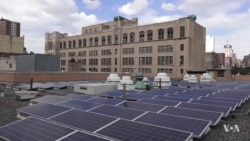Head to the roof of the New York City Lab School for Collaborative Studies and you’ll discover row upon row of solar photovoltaic panels.
The solar panels generate about 159 kilowatts of renewable energy, just a drop in New York City’s energy bucket, and are part of a citywide initiative to reduce greenhouse gas emissions to 80 percent below 2005 levels by 2050.
But not everyone is taking advantage of solar power’s promise of reduced energy bills and the rise of jobs in a new green workforce.
“Eighty percent of America is locked out of the solar market because they cannot install solar on their own rooftop,” said Steph Speirs, co-founder and CEO of Solstice, a community-shared solar power startup.
In New York City, where the majority of residents are apartment renters, the benefits of solar power are elusive. Many don’t have the means to install panels much less get access to their roof.
But community-shared solar programs are now offering city dwellers a chance at solar power. In the process, they’re also lowering barriers for access to renewable energy.
Solar in the City
At the NYC Lab School, city officials recently put out a call to solar project developers for the installation of solar panels atop 14 of New York City’s public housing properties. If all goes according to plan, up to 6,600 low and moderate-income households will be powered by 25 megawatts of solar power by 2025.
Rooftop spaces “are often underutilized,” said Mark Chambers, director of the New York City mayor’s office of sustainability. “They have a huge potential for us.”
The New York City Housing Authority will lease rooftop sites to solar project developers for a maximum of 25 years. Developers will set up and maintain the solar systems and sell power to residents.
Solar energy was the fastest growing power source in the world last year, according to the International Energy Agency.Solar capacity increased 50 percent in 2016, more than the growth of coal, wind and gas. Solar growth can be attributed to decreasing production costs and increased government support.
For city dwellers, community-shared solar programs are a way to tap into solar power’s benefits.
Like a Community Garden
Apart from using city rooftops, companies like Solstice work with off-site solar farms to provide shares of the farm to urban communities and thus allow people in inner cities to lower their electricity bills. The Boston-based startup currently has nine solar projects in Massachusetts and is expanding to New York.
“It’s like a community garden, but for solar,” said Speirs.
Solar shares are sized according to how much electricity customers use. Solstice works to enroll neighborhoods in community-shared solar programs, managing the customer experience for solar project developers.
Speirs said the average savings on a typical electricity bill is 10 percent.
“The electricity from the shared farm goes back to the grid and you as a participant see the credit show up on your utility bill every month,” said Speirs. In low and moderate-income households where every penny counts, those savings mean money can be diverted to other essentials.
Growing up, Speirs said she watched her mom struggle to pay the electricity bill. “Our product can help people like my mom save money,” she added.
Building a Green Workforce
In an industry that shows few signs of slowing down, community-shared solar programs can also provide jobs.
New York City works with Green City Force, an AmeriCorps program that trains youth from low-income communities for careers in environmental fields, including installing solar panels on city roofs.
New Yorker Miguel Rodriguez is a graduate of the program and now works as a program assistant for Green City Force. The adoption of green technologies, Rodriguez said, will inevitably change public perceptions of the public housing community, as well as perceptions among its residents.
“People will see firsthand how this will impact their community, not just in energy saving,” Rodriguez said, “The value of life around the community will be much better.”








